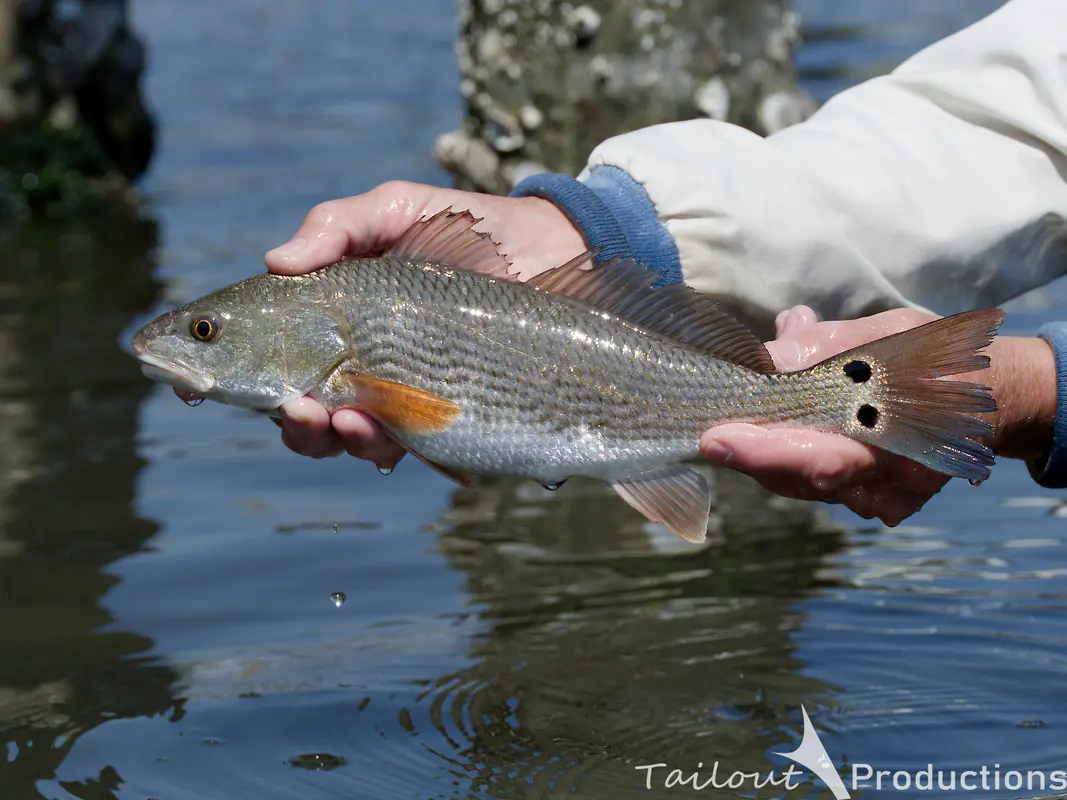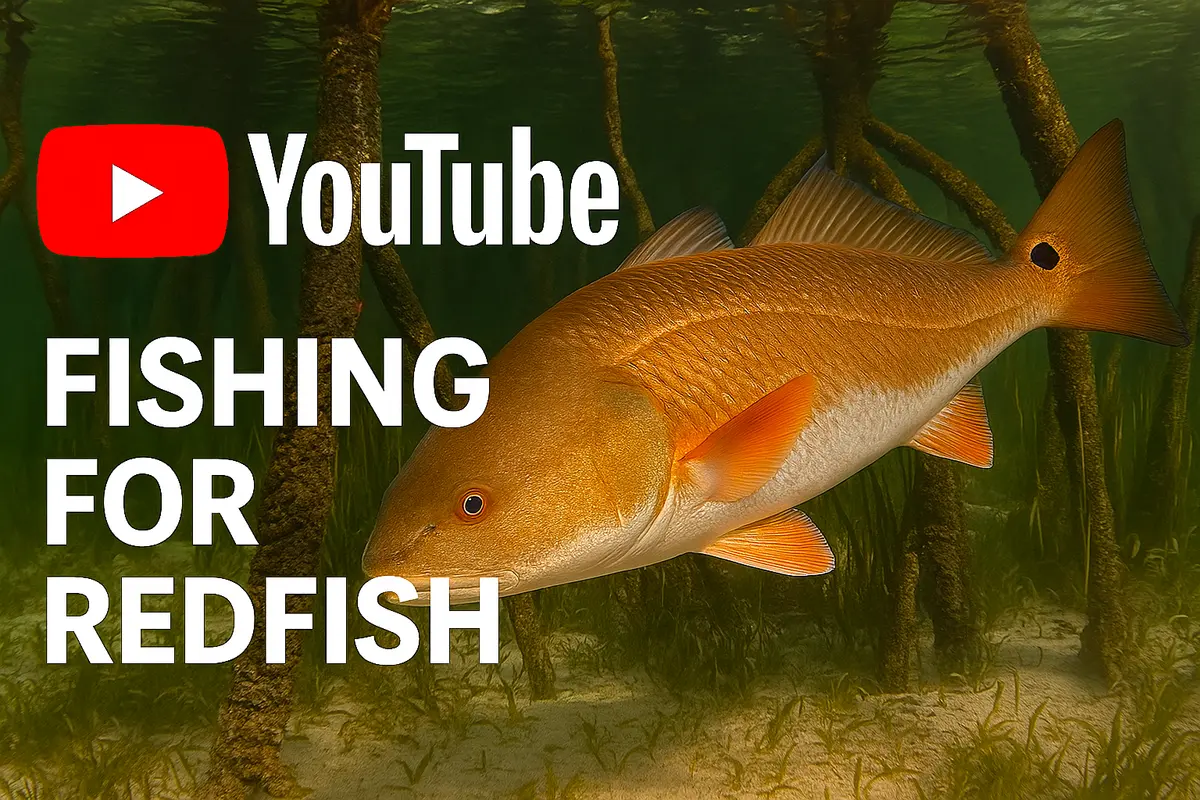Redfish: Habitats - Flats
Table of Contents
- Redfish: Habitats – Flats
- The Anatomy of Flats and Why They Hold Redfish
- 1. Seagrass Beds and Turtle Grass Meadows
- 2. Sand Holes and White Sand Flats
- 3. Oyster Bars and Shell Ridges
- 4. Mangrove Fringe Flats
- 5. Creek Channels and Drainage Runs
- Redfish Positioning Relative to Tides and Currents
- Environmental Variables That Turn the Bite
- Water Temperature
- Water Clarity
- Seasonal Movements
- Wind and Weather
- Fighting Redfish on the Flats: Avoiding Hang‐Ups & Steering Fish
- 1. Preventing Break‐Offs
- 2. Extracting Reds from Grass and Shell
- 3. Full Bail‐Run Release (When Stuck)
- 🎣 Redfish Flats Hotspots: Florida Case Studies
- 1. Florida Keys White‐Sand Flats
- 2. Biscayne Bay Grass Flats
- 3. Mosquito Lagoon Shallow Flats
- 🎥 Recommended Video
- 🧰 Recommended Gear for Redfish on Flats
- Tackle Blueprint for Flats Redfish
- Four Flats Bait Strategies & Rigs
- Presentation Techniques That Fool Flats Reds
- Sight‐Casting to Tailers
- Slow Pothole Probing
- Walking Baits Along Edges
- Drainage Lane Drifting
- Community Wisdom & Expert Tips
- Fine‐Tuning Your Strategy by Season
- Winter: Deeper Holes & Drainage Runs
- Spring: Shallow Shoals & Grass Beds
- Summer: Dawn/Dusk Hotspots
- Fall: Wide‐Open Flats Roams
Redfish: Habitats – Flats

Redfish—also known as red drum—are masters of the broad, shallow flats that rim many estuaries and bays. Flats habitats offer open water staging areas, grass‐bed ambush points, and easy access to crustaceans and baitfish. Learning how reds feed and move on flats will upgrade your flat‐fishing from random casts to pinpoint presentations.
The Anatomy of Flats and Why They Hold Redfish
1. Seagrass Beds and Turtle Grass Meadows
Flat expanses of turtle grass and shoal grass teem with shrimp, crabs, and small baitfish. Redfish cruise the edges of these beds, picking off prey flushed by their wake. Cast parallel to grass lines at mid‐tide for the best chance.
2. Sand Holes and White Sand Flats
Scoured depressions in the sand—“potholes”—hold cooler, deeper water and concentrate bait. Reds loaf in these troughs during high sun, then feed aggressively along the raised sand rims.
3. Oyster Bars and Shell Ridges
On many flats you’ll find submerged oyster bars or shell middens. These hard structures bristle with crustaceans and small fish. Sight‐fish the edges of shell lines for perched reds waiting to ambush.
4. Mangrove Fringe Flats
Where mangroves give way to open flats, a shallow shelf forms that fills on the flood. Reds stage just off the mangrove edge before roaming the flats on an incoming tide—watch for dimples at the tree line.
5. Creek Channels and Drainage Runs
Even on wide flats, shallow channels and run‐out drains create troughs that hold water at low tide. Reds patrol these “drainage lanes,” feeding on prey fleeing the flats as the tide ebbs.
Redfish Positioning Relative to Tides and Currents
| Tide Stage | Likely Redfish Station | Why Redfish Hold Here |
|---|---|---|
| Flood tide | Edges of grass beds and shell bars | Bait flushed out of cover; easier stalking in shallow water |
| High slack | Sand potholes and channel edges | Cooler depths for resting; prey concentration at holes |
| First ebb | Drainage channels and creek fingers | Ambush points for fleeing shrimp and juvenile fish |
| Low slack | Deeper depressions and creek mouths | Resting and digestion before next flood cycle |
Reading a Flat
Scan for mud rings—concentric ripples on the surface—which often mark feeding reds stirring up crabs. On clear days, polarized lenses reveal body outlines cruising just beneath the surface. In stained water, listen for the soft “skitter” of feeding.
Environmental Variables That Turn the Bite
Water Temperature
Flats reds forage best between 70–88 °F. In cooler months they may concentrate in the deepest potholes; in summer’s heat, dawn and dusk feed windows are key.
Water Clarity
Clear flats demand finesse: downsizing to lighter leaders and stealthy presentations. In stained or green water, step up to beefier tackle and scent‐enhanced baits.
Seasonal Movements
- Winter: Reds shift to deeper flats and drainage runs for warmth.
- Spring: As waters warm, schools push shallow; shrimp and crab patterns dominate.
- Summer: Strong midday sun drives fish deeper; target early morning flats.
- Fall: Reds bulk up for winter, roaming flats on falling tides—look for tailing fish.
Wind and Weather
Light winds over the flat create subtle current lines—reds hold just downstream of these seams. On windy days, fish the protected lee side of shell bars and grass edges.
Fighting Redfish on the Flats: Avoiding Hang‐Ups & Steering Fish
1. Preventing Break‐Offs
- Keep Tip Low and Constant Pressure
A low rod tip steers the fish away from shell and grass. Never let slack line form. - Feather Your Drag Smoothly
Adjust drag so sprinting fish don’t yank your rod out of your hand or break your leader. - Angle Fish Toward Open Sand
Guide reds away from structure by sweeping the rod in the opposite direction of cover.
2. Extracting Reds from Grass and Shell
- Sweep and Pump
Use short, powerful rod sweeps to free hooks from vegetation without pulling too hard on the leader. - Boat Position Control
Drift or idle slowly to keep the fish on the flats—don’t let them take you into thick grass or oyster banks. - Hand Stripping Under Tension
Strip line by hand when the fish is near cover to feel every snag and respond quickly.
3. Full Bail‐Run Release (When Stuck)
- Why It Works
A strong, straight‐line run often ejects fish from weeds or shell. - How to Do It
- Flip open the bail and keep your rod tip high.
- Let the fish run straight off into open water, then re‐close the bail and reapply drag.
- Reel carefully to regain contact before resuming the fight.
🎣 Redfish Flats Hotspots: Florida Case Studies
1. Florida Keys White‐Sand Flats
- Location: Lower Keys, between islands and channels
- Features: Expansive white sand, scattered potholes, sparse grass
- Best Season: Year‐round, peak late spring–summer
- Techniques:
- Sight‐casting to tailing fish with topwaters
- Jigging soft plastics in sand holes
- Crabbing patterns near shell lines
2. Biscayne Bay Grass Flats
- Location: Near Elliott Key and Nixon Channel
- Features: Dense shoal grass interspersed with sand patches
- Best Season: Spring through fall
- Techniques:
- Weedless shrimp imitations skipped across grass edges
- Light‐tipped popping cork rigs in drain runs
3. Mosquito Lagoon Shallow Flats
- Location: Indian River Lagoon system, near Titusville
- Features: Mixed mud, sand, and thin grass beds
- Best Season: Winter through spring
- Techniques:
- Cut bait fished on a Carolina rig along channels
- Suspended twitch baits at creek intersections
🎥 Recommended Video
For a visual guide to flats redfishing:
🧰 Recommended Gear for Redfish on Flats
- Spinning Combos:
- 7′ medium, fast‐action rod with 3000 size reel
- 10–15 lb braid, 15–25 lb fluorocarbon leader
- Lures:
- Soft‐plastic paddletails and shrimp imitations
- Small topwater plugs (walk‐the‐dog style)
- Live Baits:
- Live shrimp, small crabs
- Apparel:
- Lightweight sun shirts, polarized sunglasses, flats‐style wading boots
Tackle Blueprint for Flats Redfish
| Component | Specification | Purpose |
|---|---|---|
| Rod | 7′ medium‐fast graphite spinning rod | Sensitivity and control over flats water |
| Reel | 3000 size saltwater spinner | Smooth drag for fast runs |
| Leader | 15–25 lb fluorocarbon | Abrasion resistance against shell and grass |
| Hooks | 1/0–2/0 EWG or circle hooks | Weedless rigging for shallow structure |
| Lures | 3–4″ soft plastics, small twitch baits | Natural action over grass and sand |
Four Flats Bait Strategies & Rigs
| Bait Type | Rig | Presentation Tips |
|---|---|---|
| Live Shrimp | Weedless circle hook, no weight | Skip along grass edges, let bait settle |
| Soft Plastic | 1/8 oz jighead, weedless hook | Swim just above grass with slow twitches |
| Topwater | Small popper or stickbait | Walk‐the‐dog across shallow sand flats |
| Crab | Light split shot above circle hook | Cast to shell bars on falling tide |
Presentation Techniques That Fool Flats Reds
Sight‐Casting to Tailers
Spot the “V” wakes and cast just ahead of the fish’s path—let the lure land softly and work away.
Slow Pothole Probing
Drop a soft plastic into sand holes and pause, letting subtle twitches trigger strikes from waiting fish.
Walking Baits Along Edges
Use a steady “walk” retrieve on topwaters or skirted jigs to mimic fleeing bait along grass rims.
Drainage Lane Drifting
Drift with the current over shallow channels, pitching baits up‐current and letting them swing through the run.
Community Wisdom & Expert Tips
- Boat control is everything. Use a push‐pole or trolling motor on low to maintain stealth.
- Eyes in the sky. When possible, scout flats from a kayak or stand for better sight‐fishing angles.
- Match the hatch. Size and color of shrimp/soft plastics should mimic local forage.
- Study the tide. Fast‐moving flood and ebb currents concentrate bait—and reds—along obvious travel lanes.
- Hands wet, quick release. Handle fish carefully and minimize air exposure for a healthy return.
Fine‐Tuning Your Strategy by Season
Winter: Deeper Holes & Drainage Runs
Target deeper depressions and back‐channels holding warmer water.
Spring: Shallow Shoals & Grass Beds
Look for aggressive feeds as bait becomes abundant in warming flats.
Summer: Dawn/Dusk Hotspots
Beat the heat—fish shallow before sunrise and after sunset when flat waters warm.
Fall: Wide‐Open Flats Roams
Reds scatter across flats feeding heavily; cover water quickly with topwater and soft plastics.
Click the thumbnail above for step‐by‐step flats redfish tactics.
| Popular YouTube Searches | Watch |
|---|---|
| Flats redfish sight fishing tips |  |
| Topwater flats redfish techniques |  |
| Best tides for flats redfish |  |
| Soft‐plastic rigs for flats |  |
| Crab patterns flats redfish |  |
Ask AI for More Info
Try our AI assistant for free—sign up to access this powerful feature.
👉 Sign Up to Ask AI